
6 Most Important Pieces of Info to Share with Your Tech Installer
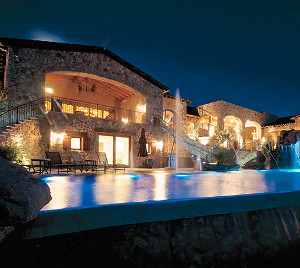 Tidbits about your lifestyle, family and home can net a well-designed A/V and automation system. Tidbits about your lifestyle, family and home can net a well-designed A/V and automation system.
A realtor wouldn’t dream of selling you a house without understanding your needs and wants (or “must-haves” as they’re known these days). The same goes for the professional who designs and installs A/V and automation systems into homes. In order to provide a customer with technology that will truly enhance the convenience, comfort and entertainment value of a home, he needs to learn about how those homeowners live in their home now, what they’d like to improve about the house and how they envision life in an automated residence, among other tidbits. (To see home tech requests achieved to their fullest, check out our Home of the Year Award winners.)
“It’s like peeling back an onion,” says custom electronics (CE) professional Tommy Kissell of Texas-based Eco High Fidelity, of his first meetings with prospective clients. “The more we know about a client, the better equipped we’ll be to design a system that suits their habits, routines, schedules and lifestyle.” So what are some of the areas you can expect your CE pro to ask you about?
The House Itself
Certainly, he’ll need to know whether you plan to automate an existing house, will be remodeling or would like to put the system into a house that’s on the drawing boards. Some of your first meetings with a CE pro could take place at your house; this will give the installer an opportunity to gauge the complexity of the job. He’ll need to see if there’s an attic, basement or crawlspace through which to fish cabling; if not, he may investigate other wiring avenues. He’ll be able to see first-hand if there are any materials like concrete and stucco that could make the project more difficult. Also, he’ll probably ask you about current technologies your home might already have: built-in speakers, a computer network, a security system? With a clear understanding of your home’s makeup, a CE pro will be able to determine the types of tools and manpower he will need to get the job done, and what types of products and systems—for example, wireless or hardwired—will work best.
Inconvenient Truths
Everybody can rattle off a few items they find annoying or inconvenient about their home. Maybe it’s the closet and bathroom lights that nobody bothers to turn off, or the tedium of locking up and shutting things off before bedtime. A CE pro wants to hear your pet peeves you so he can design your system that takes care of those trouble spots. Don’t hold back, and make sure every member of the family has a say.
Comfort with Technology
How do you use technology in your home now? For example, are you a fan of streaming music and video services? Are you a PC or Mac user? Do your kids do much of their homework online? What about mobile devices? Are they loaded with apps? A CE pro can tell a lot by your current use of and familiarity with technology. For example, if everyone in family is an avid user of an iPad, your CE pro may design a system that lets you use this device to manage and monitor your home systems. If you have thousands of CDs, then those might be prioritized within a whole-house audio system over streaming services, for example (or perhaps you’d rather pare down the collection and simplify to the streaming route).
Way of Life
Lifestyle is a big buzzword in the home technology industry, and for good reason. A candid discussion of your way of life will likely reveal the most important pieces of information a CE pro needs to design and implement a system so in sync with you and your family that you’ll wonder how you ever managed without it. At the very least, expect to divulge your household status (single, married, kids, elderly parents), your family’s schedule (work, school, travel), your social life (do you entertain frequently) and your hobbies (sports, exercise, photography, art collecting, etc.). If your daily routine involves a half hour on the treadmill, perhaps you’d like to have some music piped in over in-ceiling speakers rather than be tethered to an iPod; or maybe create the proper lighting environment for displaying artwork.
Aesthetic Preferences
Do you want to show off your home electronics investment or keep it under wraps? Your aesthetic preferences will help a CE pro decide whether he should install speakers that recess into the walls or models that stand out in the open, for example. If you like the idea of having all of the A/V components (amplifiers, processors, Blu-ray players, etc.) hidden completely from view, by all means tell your CE pro. There are lots of clever ways to hide technology.
On the Clock
Prepare to have an idea of when you’d like the project started and finished. Do you want everything installed by the holidays? Is there a special event by which you’d like the project buttoned up? Based on answers to earlier questions, a CE pro is probably visualizing a system, but when you say you want it done in six weeks, he may have to rethink the plan, or may even bow out if you’re firm on the deadline. Be clear with your timeframe; be flexible if you can.
by Lisa Montgomery
http://www.electronichouse.com/article/6_most_important_pieces_of_info_to_share_with_your_installer/Learning_Center
Custom Installation Services, LLC – Call us for your free “Tech” evaluation! in Charlotte, NC and surrounding areas
Posted in 3D TV, APC, Apple, AppleTV, Audio Systems, Automation, Blu-ray, Bose Dealer, Central Vac System, HDMI Specs, Home Theater, Home Theater Design, Home Theater Setup, IP Cameras, iPad, iPhone, lifestyle, lighting control, Linksys, Low Voltage Contractors, Luxul, Media Rooms, Multi Room A/V, Netgear Routers, Network Setup, Outdoor Speakers, recycling, soundtouch, Structured Wiring, technology, Theater Seating, wave radio, Wireless Network
|
The Cabling Industry Needs a Makeover
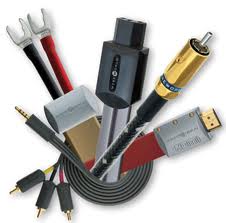 It’s time for the cabling industry to reassess how it approaches marketing to consumers. It’s time for the cabling industry to reassess how it approaches marketing to consumers.
I find Twitter entertaining and, at times, almost addicting. This morning a tweet from Production Advice’s Ian Shepherd shocked me with concern for an electronics category that I think is beneficial: cabling.
Shepherd retweeted a blog written by L.A. recording engineer Bobby Owsinski, who blogged about a 2008 Engadget story that asked 12 “audiophiles” to compare an audiophile cable brand with another cabling product. It turns out the other cabling product was a set of coat hangers. The crux of the story is that those audiophiles couldn’t tell the difference between coat hangers and expensive cables.
Adding insult to injury, Owsinski points out the obvious difference between the audiophile community and professional sound engineers that use their listening skills for work by noting, “‘audiophiles’ showed just why they get so much abuse from pros over their so-called “golden ears.”
Monster was the cable manufacturer in question in Engadget’s blind testing, and Owsinski says Monster does make good products; the problem, in his opinion, is with how the products are marketed. “Monster Cable takes some reasonably good cable and markets it in such a way that its perceived value is a lot greater than it deserves to be,” he asserts in his blog. “The problem is that for speaker cable, 12 or 10 gauge zip cord [lamp cable] will work just as well as expensive Monster cable.”
Unfortunately for the cabling industry, Owsinski isn’t alone in his opinion, and websites such as Audioholics.com fuel the public’s disdain for cabling by publishing stories that attack the credibility of many of the cable category’s claims for improved performance.
Like Owsinski, Gene DeSalla at Audioholics points out that Monster and other brands aren’t necessarily bad, its just that their products don’t measure up to the claims.
To rectify this problem, I think it’s time for the cabling category to own up to its self-generated hyperbole and tone it down. Let’s start by addressing the claims of exotic materials, proprietary construction techniques and slick geometry designs that contribute to their out-of-this-world performance claims without any third-party verification.
Manufacturers should look to develop products that are affordable to consumers in these difficult economic times. Too often, critics point to the steep price tags attached to some cabling products and note that a consumer could buy a nice car or place a down payment on a house with the amount of money some companies ask for a pair of speaker cables.
The last thing the cabling industry needs to do is educate the public on the benefits of a properly designed cable that employs quality materials. Owsinski says cabling can make a difference in how a system performs, and I believe he is correct. Using dealers, let’s teach consumers on how to buy cable and how to listen.
One other suggestion I would make is that maybe we should think about locking audiophiles in the basements from which they came. For all their passion about music and equipment, they inflict a lot of irreparable damage to an industry that can hardly afford the scrutiny of a public that doesn’t respect their collective opinions. OK, OK, I’m only kidding about that last suggestion, but I would take away their Diana Krall and Patricia Barber CDs and LPs as punishment for their past transgressions.
By Robert Archer
http://www.cepro.com/article/the_cabling_industry_needs_a_makeover/K536
Custom Installation Services, LLC – ”We may be a few dollars more than the competition, but we are a million times better”.
Posted in 3D TV, APC, Audio Systems, Blu-ray, Gaming Systems, Home Theater, LED, Media Rooms, Multi Room A/V, Structured Wiring, technology
|
Tagged 3d ready preamps, 3d theater in charlotte, apc or panamax, ashville nc strucuted cable, audio advice, audio and video equipment for sport bars, audio video architects charlotte nc, audio video installations charlotte nc, Best Buy, central vac dealers in charlotte nc, central vacuum installation charlotte nc, charlotte custom home builders, charlotte hd installers, Charlotte Home Theater, Charlotte onkyo dealers, Commercial electronics integrators, custom home builders in charlotte nc, custom home charlotte audi video, custom house tv charlotte, custom tv installations charlotte, customhome integration mooresvillenc, geek squad in charlotte nc, home audio consultation and design, Home Theater, innovative systems, speakercraft dealers in charlotte nc, tv installation above fireplace charlotte nc, universal remote service lake norman, whole house audio, zobo
|
Comparing DLP, Plasma, Projection 3D Systems
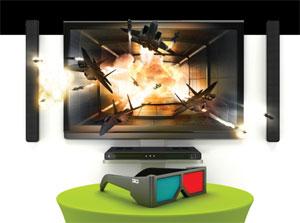 We compare pros and cons of projector, DLP, and flat-panel 3D setups. We compare pros and cons of projector, DLP, and flat-panel 3D setups.
3D comes in many shapes and flavors. You can buy a flat-panel TV with the capability, or go for the larger screen sizes of a DLP TV. The other option is a video projector.
All have their merits as you’ll read about in the following profiles. After reading them, you should have a better idea of which 3D formula will work best in your home.
Of course, no TV is worth a grain of salt without speakers and source equipment, so we’ve included a list of components used in each profiled 3D setup. This, combined with each homeowner’s impressions about 3D viewing, will help you put together your own 3D entertainment system.
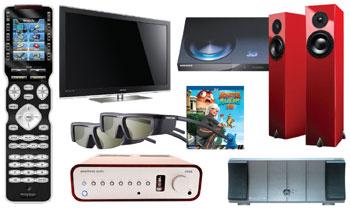 The Entire System: URC MX-980 remote; Peachtree Nova preamplifier/DAC; Samsung 58-inch PN58C7000 kit (Blu-ray player, two pairs of glasses and Monsters vs. Aliens); Totem Acoustic Forest freestanding speakers; Integra Research RDA-7.1 amplifier Plasma: Space-Saving 3D
For three years Gabe Montemurro and his wife, Elizabeth, had been using a Sony SXRD rear-projection TV – quite happily. But the thought of being able to view content in 3D was too compelling for these early adopters to ignore. Plus, since the Montemurros’ baby was now walking, they thought it would be best to buy a slimmer flat-panel display that could be pushed inside their entertainment cabinet and beyond the toddler’s reach.
Gabe had a few other prerequisites for a new display besides being flat: it had to be on the higher end of the performance scale, it had to be plasma and it had to be somewhat affordable. Samsung‘s high-def PN58C7000 TV fit the bill, coming in at under $3,000. As a bonus, the 58-incher came packaged with a 3D Blu-ray player, two pairs of 3D glasses and a 3D Blu-ray disc of Monsters vs. Aliens.
After a few viewings of the movie, the Montemurros were hooked. “3D is much more immersive than 2D,” says Gabe. “You find yourself leaning forward, sitting on the edge of your seat.” Unfortunately, there are only so many times you can watch the same movie. “Monsters vs. Aliens is the only true 3D source we own, and when we purchased the system in March there simply wasn’t much content available,” Gabe laments.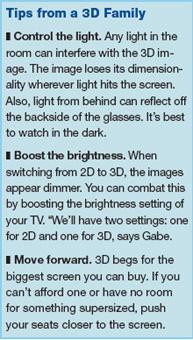
Even with the lack of 3D programming, the family still gets to experience bits and pieces of 3D just by pressing the 3D button on the TV remote control. The PN58C7000 features proprietary 2D-to-3D conversion technology, which when activated renders 2D images to near 3D quality. “If it wasn’t for the conversion technology, 3D for us would be extremely disappointing,” says Gabe.
The best way to describe the conversion, says Gabe, is faux 3D. “It’s really hit or miss. Some things you watch, you say, ‘Wow, that really added some depth.’ Other things fall completely flat.” The Montemurros have experimented with all sorts of programming and content: movies, sports, digital pictures and PlayStation 3 video games. “I watched a recording of the Super Bowl, and there were some camera angles where the action appeared 3D. The same with hockey. The 3D conversion added nothing to an animated show like The Simpsons, but gave the sense of actually riding in a car during a NASCAR PS3 game.”
They were most impressed, however, with how their collection of digital pictures looked when displayed in 3D. “Suddenly, there was so much depth and dimensionality, so much so that I went through my favorites and created a special 3D playlist,” Gabe says.
So what about the kooky glasses that came with their 3D package? “I’d rather not have to wear them,” says Gabe, “but hey, it’s worth it to experience a new technology like this.”
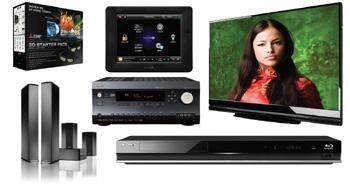 The Entire System: Mitsubishi 3D starter pack; Definitive Technology speakers; Control4 TSM10GB touchpanel; Integra DTR 7.9 receiver; Sony BDP-S570 Blu-ray player; Mitsubishi 73-inch WD-73837 DLP: 3D Trade-up
As a longtime fan of Mitsubishi products, Mark Capriola is benefiting from the manufacturer’s commitment to the new viewing technology. The audio and video enthusiast recently traded in his 65-inch WD-65833 Diamond DLP TV for a 73-inch WD-73837 Diamond DLP unit. In the process, he got a full 3D upgrade, “something he loved the idea of,” says custom electronics professional Dirk Dutton of Primetime Audio Video in Rockford, Ill.
The fact that the new screen was much larger than the biggest 3D flat panel available, yet cost significantly less, was one more plus. Primetime sold the set to Mark for $2,400 (plus $399 for a starter kit, which includes two sets of glasses and an HDMI adapter); a 63-inch 3D Samsung flat panel, which Primetime also sells, would have cost closer to $3,000, says Dutton.
“You can’t really beat a DLP in terms of price and screen size.”
Although his loyalty to Mitsubishi had a lot to do with his choice, Capriola says he was willing to give flat-panel options a fair shake. “I visited the Primetime showroom before I bought anything to compare five or six different displays. The DLP TV had the horsepower I was looking for.”
Aside from making room for the larger set, there was little Primetime had to do to Capriola’s living room to make it suitable for the new display and its 3D presentation capabilities. Even the audio was good to go, thanks to their existing 5.1 surround-sound setup of an Integra receiver and Definitive Technology speakers.
“All we really had to do was program it into the home’s existing Control4 home automation system,” says Dutton. This tie-in allows the DLP to display menus for operating the home’s audio/video equipment, lights and other systems. Primetime also created a special 3D button that switches the DLP from 2D mode to 3D. Capriola navigates to the command by using his iPad or a handheld remote.
That same command kick-starts a Sony Blu-ray player, another recent addition to the entertainment system. Previously, Capriola was using a PS3 to play Blu-ray movies – a good choice, “but the Sony player is able to load movies a lot faster, and we didn’t really want to wait for the PS3 3D update,” says Dutton.
The combination of the 3D button and the Sony Blu-ray player makes the transition between 2D and 3D seamless, and eventually so will the sources in Capriola’s well-stocked equipment rack in the basement. Wired to the TV through a Control4 video distribution processor are a Vudu BX100 set-top box, Dish Network VIP922 satellite receiver and Sony BDP-CX7000ES Blu-ray player, among other components. Some of these content providers have already started to offer 3D programming – with much more to come – so Capriola’s assortment of 3D choices is bound to keep growing.
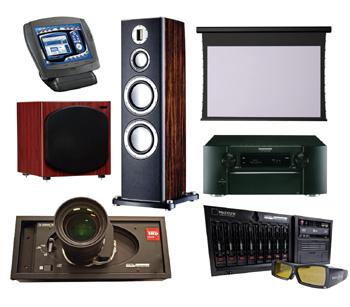 The Entire System: Crestron TPMC-8X; Monitor Audio Platinum 300 speakers and GSW-12 subwoofer; Digital Projection 3D Titan; Stewart Filmscreen Luxus ElectriScreen StudioTek; Marantz AV8003 receiver; Mechdyne Dimension server Projection: Private 3D Demo
The owner of this high-end theater had only a standard video projector installed when 3D started to get hot. Unsure of whether he should trade in his recently purchased projector for a 3D model, he agreed to let the company that designed his theater demonstrate a unit in his home first. “We told him we’d give him a deal on the installation of the new projector if he’d host an open house for builders and clients in the area,” says Shawn Hansson of Logic Integration in Denver.
The Logic Integration installers temporarily staged the Digital Projection International (DPI) 3D Titan projector on a table, leaving the existing DPI 1080p Titan projector mounted to the ceiling. Also left for the demo was the 130-inch Stewart Filmscreen – a perfect size for 3D viewing, according to the homeowner.
As part of its $130,000 3D package, DPI includes a Dimension server from Mechdyne with the Titan projector. The server comes preloaded with a variety of 3D material, and it left a lasting impression on the homeowner.
“We watched everything from cartoons and advertisements to video games and movies, and it all was so much more immersive than the 2D content I typically watch. The difference is almost comparable to black-and-white television to color.”
What made the biggest impact, says the homeowner, were the active shutter glasses that came with the system. “I’ve used polarized glasses before, and it just doesn’t compare to the 3D quality you get from active shutter glasses. You’re able to see the full 1080p image.”
The gathering was a huge hit, especially for the homeowner, who was able to experience 3D from a $130,000 projector in the comfort of his own home. Was it enough to convince him to upgrade? “Not yet,” he says. “The cost is still too high and there’s not enough content available.” But when things change, “I’ll be seriously looking at a new projector.”
by Lisa Montgomery
http://www.explore3dtv.com/article/14956/Comparing-DLP-Plasma-Projection-3D-Systems/?textpage=1
Custom Installation Services, LLC – We specialize in fixing the $99 TV install by our “competitors”!
Posted in 3d movies, 3D TV, APC, Audio Systems, Automation, Blu-ray, Flat Panel TV's, Home Theater, i-Pad, LED, Media Rooms, Multi Room A/V, Music and Movies, News, technology, Theater Seating
|
Tagged 3d theater in charlotte, a/v companies charlotte nc, audio advice, audio installers in mooresville, audio video installation charlotte nc, audio video integrators charlotte nc, best solution for hide away tvs, boone home theater, ccp mx-3000, charlotte audio advice, charlotte custom home builders, charlotte hd installers, cis home theatres, cis hulu, cis-nc.com, custom home integration nc, custom home integrations nc, custom house audio, custom house audio video charlotte nc, custom installation, geek squad in charlotte nc, home audio consultation and design, home automation companies in charlotte, home entertainment installat-, Home theater installers Lake Norman, innovative systems, lake norman home theatre design, mooresville theaters, speakercraft dealers in charlotte nc, tweeter charlotte
|
|
|
|
 Tidbits about your lifestyle, family and home can net a well-designed A/V and automation system.
Tidbits about your lifestyle, family and home can net a well-designed A/V and automation system.








